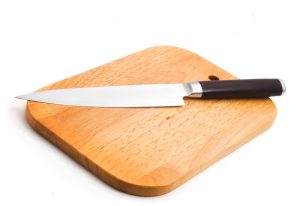Are you looking for the perfect cutting board to enhance your culinary experience? Confused between a Bamboo or Hinoki Cutting Board? Look no further! This Hinoki vs Bamboo cutting board guide will explore the durability, maintenance, and cutting performance of these two popular options.
Whether you’re a professional chef or an aspiring home cook, choosing the right cutting board is essential for both knife safety and longevity. So, let’s dive in and discover which cutting board will best serve your kitchen needs!
Key Takeaways
- Hinoki cutting boards are made from Japanese cypress tree wood and are known for their strength and resistance to wear and tear.
- Bamboo cutting boards are also durable but may not last as long as hinoki boards and can be prone to splitting and breaking over time.
- Regular cleaning and oiling are essential for maintaining the longevity of both hinoki and bamboo cutting boards.
- Both hinoki and bamboo cutting boards offer excellent cutting performance and knife safety, with hinoki’s natural oils providing a smooth surface and bamboo’s hardness suitable for heavy-duty chopping.
Hinoki Vs Bamboo Cutting Board: Durability and Longevity
If you’re looking for a cutting board that will last a long time, you should consider the durability and longevity of the material.
When it comes to durability, Hinoki cutting boards are a top choice. Made from the wood of the Japanese cypress tree, hinoki is known for its strength and resistance to wear and tear. It can withstand heavy use and won’t easily warp or crack.
On the other hand, bamboo cutting boards are also durable but may not last as long as Hinoki boards. While bamboo is a strong material, it can be prone to splitting and breaking over time.
So if you’re looking for a cutting board between Hinoki vs Bamboo cutting board that will stand the test of time, Hinoki is the way to go.
Hinoki Vs Bamboo Cutting Board: Maintenance and Care

To keep your cutting board in good condition, remember to regularly clean and oil it. Proper maintenance and care are essential to ensure the longevity of your Hinoki or Bamboo cutting board.
After each use, wash the board with warm soapy water and a soft sponge or cloth. Avoid using harsh detergents or abrasive materials that can damage the surface. Once clean, pat it dry with a clean towel and let it air dry completely before storing.
To prevent the growth of bacteria, it is recommended to oil your cutting board regularly. Apply a food-grade mineral oil or a specialized cutting board oil to the surface, allowing it to penetrate the wood. This will help preserve the moisture balance and prevent cracking or warping.
Following the simple steps in this Hinoki vs Bamboo cutting board comparison, you can maintain a clean and hygienic cutting board that will serve you and your loved ones for years.
Hinoki Vs Bamboo Cutting Board: Cutting Performance and Knife Safety

A well-maintained board’s cutting performance and knife safety are crucial for efficient and safe food preparation. When it comes to serving others, you want to ensure that your cutting board performs well and keeps your knives sharp and your hands safe.
Both hinoki and bamboo cutting boards excel in these areas. With its natural oils and antimicrobial properties, Hinoki provides a smooth surface that minimizes knife resistance and helps maintain a sharp edge.
On the other hand, bamboo is known for its hardness and is a budget-friendly option, making it an excellent choice for a chopping block.
Both options offer a good grip, preventing the board from sliding and reducing the risk of accidents.
So, whatever you choose after this Hinoki vs Bamboo cutting board comparison, you can trust that your cutting board will enhance your cutting performance and prioritize knife safety, allowing you to serve others confidently.








Konnichiwa! (Hello!) I'm Pat Tokuyama, a Japanese tofu cookbook author, who travels for music, food, and adventure. If you like Japanese tea, checkout some of the newestorganic japanese tea, matcha bowls and noren and more!
** Curious about the Plant Based Japanese Cooking Club? ** Learn more here!